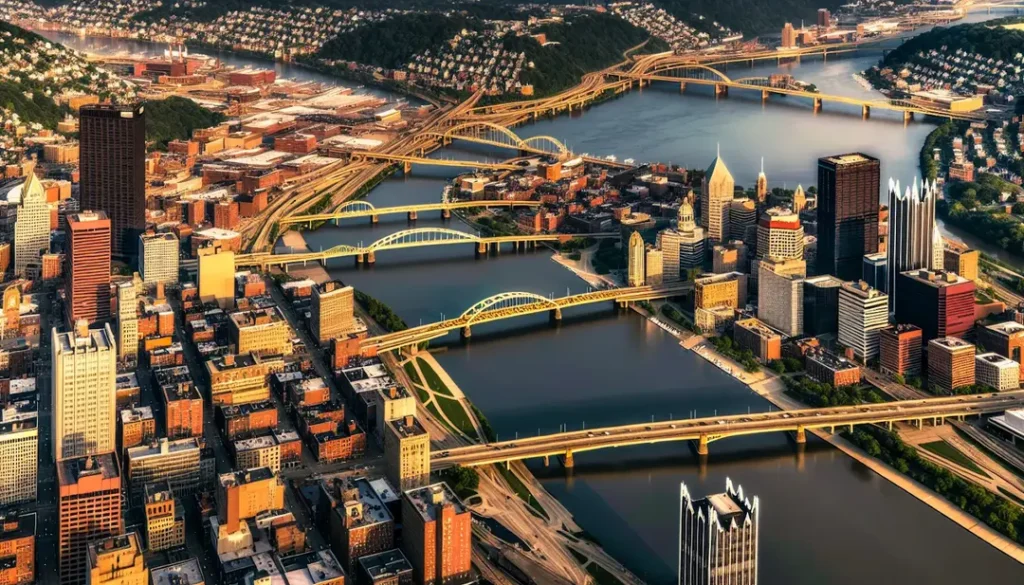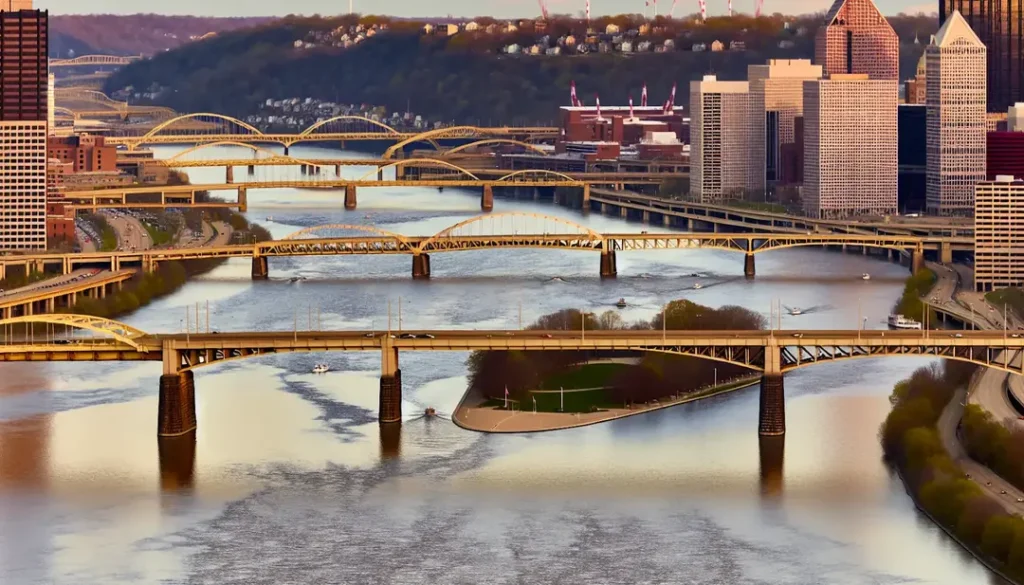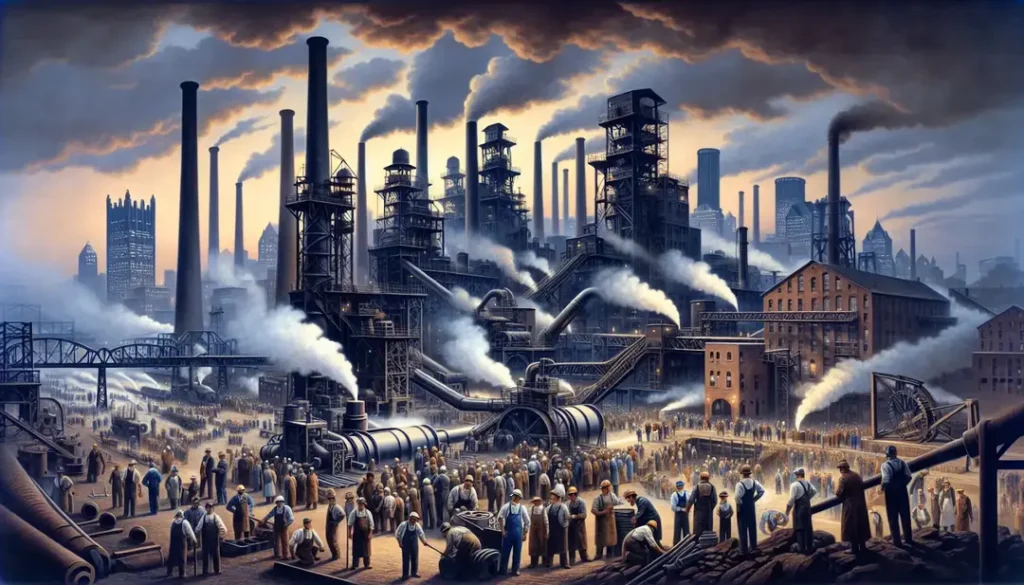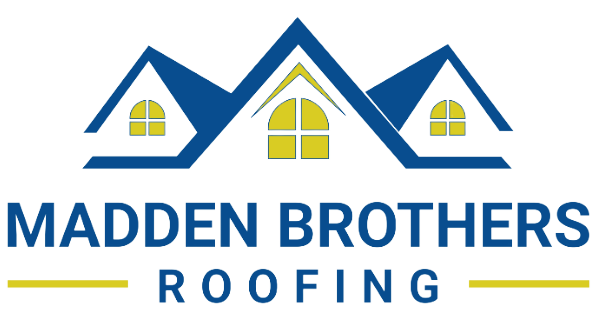Is it seeking the essence of Pittsburgh, PA? This guide dives into the city’s identity—forged by the confluence of the Allegheny and Monongahela Rivers into the Ohio and sculpted by a history of steel, sports, and academia.
Discover the highlights and hidden gems of Pittsburgh, a city with a population of close to 300,000 residents. Here, iconic bridges span vibrant neighborhoods, and innovation shapes its future.
Begin your discovery of what the Pittsburgh area has to offer, from its robust culture to its economic resurgence.
Key Takeaways
- Pittsburgh is a culturally and historically rich city located in the southeastern region of Pennsylvania, known for its picturesque river city landscape as the Allegheny and Monongahela Rivers form the Ohio River.
- The city’s economy has transitioned from steel to service industries, with significant growth in sectors such as healthcare, education, and technology contributing to a per capita income of $54,306 as of 2024.
- Pittsburgh’s housing market is dynamic, with median home prices reaching $217K and homes selling after an average of 57 days on the market as of December 2023 amidst a backdrop of neighborhoods, each offering distinctive living experiences.
Exploring Pittsburgh’s Heart

From the East Liberty neighborhood to the bustling Greater Pittsburgh area, the city’s heart beats with a rhythm of its own. The confluence of the Allegheny River and the Monongahela River in downtown Pittsburgh, forming the Ohio River, paints a picturesque river city landscape that’s hard to forget.
And then there’s the iconic Fort Duquesne, a historical landmark that stands as a testament to Pittsburgh’s rich past, nestled within the city’s thriving downtown.
The Carnegie Museums, including the Carnegie Science Center, stand tall amidst Pittsburgh’s bustling streets, symbolizing the city’s unique fusion of history and modernity. From the West End to the heart of the city, every corner of Pittsburgh tells a story of its own, inviting you to explore and immerse yourself in its rich culture and history.
Pittsburgh Geography: Where is Pittsburgh, PA in the US
Tucked away in the southeastern region of Pennsylvania, Pittsburgh is a city that’s rich in cultural, historical, and geographical significance. Pittsburgh, positioned in the north-eastern part of the United States, shares its state borders with six other states:
- West Virginia
- Delaware
- Ohio
- New York
- New Jersey
- Maryland
Pittsburgh geography has many advantages that further enhanced by its proximity to major cities like:
- Akron, OH
- Cleveland, OH
- Columbus, OH
- Buffalo, NY
- London, Canada
The city is home to the Pittsburgh Pirates, who play their home games at the iconic PNC Park. The city’s location at the foothills of the Allegheny Mountains, where the Allegheny and Monongahela Rivers merge to form the Ohio River, makes it a unique American city with a rich ecological and industrial heritage.
What is Pittsburgh PA Coordinates
Pittsburgh’s geographical coordinates, 40.4406° N, 79.9959° W, place it at a strategic location that played a significant role in the city’s development. Pittsburgh became a critical stop for westward-bound settlers after the American Revolution due to its strategic location along the Ohio River.
The city’s coordinates are as much a part of its identity as its rich industrial past and vibrant cultural present.
What is the Pittsburgh, PA Population
With an estimated population of 293,501 in 2024, Pittsburgh is a bustling city that’s as diverse as it is vibrant. This city, the principal town in the Pittsburgh metro area, plays a significant role in the region’s economy and culture. From the thriving downtown area to the quiet suburban neighborhoods, every corner of Pittsburgh is a testament to its booming population and the vibrant community spirit that defines it.
Over the past decade, the population of Pittsburgh has seen fluctuations, with the city’s population standing at 293,501 and the metropolitan area population estimated at around 1,700,000 in 2021. Despite these fluctuations, the city’s population continues to grow, with an anticipated population of approximately 330,000 by 2030.
What is Pittsburgh PA Time Zone
Pittsburgh operates under the Eastern Standard Time (EST) with a UTC/GMT offset of -5 hours, aligning its clocks with several other major cities across the United States. This makes it easy for residents and businesses in the city to communicate and conduct transactions with their counterparts in other major cities across the country.
The city’s location in the Eastern Time Zone, which is situated 1 hour ahead of the Central Time Zone, is a boon for international business communications. The Eastern Time Zone in Pittsburgh corresponds with significant cities in the United States and Canada, aiding in the seamless facilitation of business operations and communication with these crucial trading partners.
What is Pittsburgh PA License Plate
Pittsburgh, PA’s license plate embraces the ‘Family of Plates’ color scheme, featuring blue, white, and yellow. It prominently displays the word ‘Pennsylvania’ at the top and ‘VisitPA.com’ at the bottom. This design symbolizes the affection for Pittsburgh, PA, and adds a personal touch to every vehicle that proudly displays it.
The Pittsburgh, PA license plate features:
- The slogan ‘visitPA.com’
- Measures 12 inches by 6 inches
- Constructed of aluminum
- Adheres to the serial format of ABC-1234, making every plate unique and readily identifiable
These plates are more than just identifiers; they’re a symbol of Pittsburgh’s charm and identity.
What is the Telephone code of Pittsburgh, PA
Pittsburgh, PA, is marked by area codes 412 and 878, indicating the city’s identity in the extensive network of American telecommunications. Whether you’re dialing in from another state or reaching out to someone in Pittsburgh from across the globe, these area codes connect you to the vibrant voices of the city.
Assigned in 1947, the 412 area code is a historical relic in itself. It reflects the city’s growth and expansion over the years and its significance in the nation’s telecommunication network. Today, whether you’re dialing a loved one or a business associate, these area codes connect you to the heart of Pittsburgh.
What are the Towns/Cities of Pittsburgh, PA
Ranging from the Allegheny Center to Neville Township, Pittsburgh, PA, encompasses numerous towns and cities in Allegheny County, each showcasing its unique character and charm. Some of the neighborhoods in Pittsburgh include:
- Allegheny Center
- Bloomfield
- Lawrenceville
- Shadyside
- Squirrel Hill
These neighborhoods exhibit diversity, with each having its unique history, culture, and character.
From Lawrenceville and East Liberty’s modernity to Shadyside and Squirrel Hill’s historical allure, Pittsburgh is a city of many faces, each one more fascinating than the last.
Demographics Pittsburgh: The People
Pittsburgh is home to a diverse and vibrant population. The city’s demographic breakdown includes approximately:
- 65.42% White
- 22.89% Black or African American
- 5.58% Asian
- 4.83% Two or more races
- 1.05% Other race
- 0.18% Native American
The city also boasts a significant presence of German, Italian, and Hispanic/Latino communities, concentrated in neighborhoods such as Troy Hill, Mt., Brookline, Bloomfield, Morningside, Oakland, and Beechview/Brookline.
This show casing the Demographics Pittsburgh to be multicultural melting pot has contributed to Pittsburgh’s rich cultural tapestry, making it a truly global city.
River City Landscape

Pittsburgh is known as the “City of Bridges,” and for good reason. With the convergence of the Allegheny River and the Monongahela River forming the Ohio River, Pittsburgh is a river city in every sense. The city is home to a total of 446 bridges, symbolizing the city’s connection with its riverine terrain and the necessity to cross its numerous waterways.
These rivers not only define the city’s landscape but also contribute significantly to its economy and transportation network.
Pittsburgh Culture: Topographical Tapestry
Pittsburgh’s topography is as diverse as its culture. From its highest elevation, reaching 1,371 feet above sea level, to its stunning river valleys, the city is a topographical tapestry that offers breathtaking views and unique landscapes. The city’s diverse terrain plays a significant role in the distribution of air pollution, at times trapping or channeling it due to the presence of hills, bringing Pittsburgh Culture to the forefront.
But it’s not just about the hills and valleys; Pittsburgh’s topography also presents distinctive views, including:
- The West End/Elliot Overlook
- The Upper Platform of the Duquesne Incline
- The North Shore
- Grandview
- Emerald View Park in Mt. Washington
- Schenley Park
A Storied Past: Pittsburgh’s Rich History

Pittsburgh’s storied past is a tale of growth, resilience, and transformation. From its establishment in 1758 to its emergence as a critical player in the steel industry, the city has a rich Pittsburgh history that has shaped its unique identity. The town was given its name by General John Forbes, who honored British statesman William Pitt, the Earl of Chatham. This marked the beginning of its existence as an American city.
Over the years, Pittsburgh has been the location of several significant events, including:
- The French and Indian War
- The Revolutionary War
- The Whiskey Rebellion
- Its involvement in the Civil War through the Underground Railroad stops.
Birth of an American City
Established as a borough on April 22, 1794, and achieving city status on March 18, 1816, Pittsburgh has come a long way. The city’s growth was propelled by its plentiful coking coal and the growing iron and steel industries, attracting pioneers like:
- James Wilson
- Andrew Carnegie
- Henry Clay Frick
- Andrew W. Mellon
- Charles M. Schwab
Despite the challenges faced by the early settlers, including the depletion of resources such as coke and iron ore, issues stemming from industrialization, and the limited availability of land for new settlements, Pittsburgh emerged as a city of promise and opportunity.
The Steel Industry Saga
The steel industry played a significant role in shaping Pittsburgh’s economy and cultural identity and fostering a community known for its hard work and industrial strength. The sector attracted many European immigrants, who contributed to the city’s diverse cultural landscape. The industry’s decline in the 1980s posed a challenge to the city’s foundational symbols, leading to active efforts to redefine Pittsburgh’s image.
Despite these challenges, the city undertook efforts to preserve its steel industry legacy, reminding us of the city’s resilience and its ability to adapt and evolve.
Landmarks of Yesteryear
Pittsburgh is home to numerous historic sites and landmarks that tell the story of its past. Some of the city’s notable landmarks include:
- The Phipps Conservatory and Botanical Gardens
- The Cathedral of Learning
- The Andy Warhol Museum
- The Heinz History Center
- The Duquesne Incline
- The Point State Park Fountain
But it’s not just about the grand structures; even the humble neighborhoods and streets hold historical significance.
These landmarks, each with its unique history and charm, invite you to explore the city’s past and discover the stories that have shaped Pittsburgh into the city it is today.
Pittsburgh Economics the Evolution: From Steel to Services
Pittsburgh has experienced a considerable economic transformation over the years, transitioning its focus from steel production to service industries. The city has diversified its economy by focusing on sectors such as healthcare, education, and technology, proving its resilience and adaptability.
Despite the decline of the steel industry, the city has managed to reinvent itself, emerging as a hub for innovation and economic growth. Today, Pittsburgh is home to leading healthcare providers, top universities, and a thriving technology sector, marking a new chapter in the Pittsburgh economic narrative.
Healthcare and Pittsburgh Education Pioneers
Pittsburgh’s healthcare and education sectors have played a key role in its economic transformation. The city is home to leading healthcare providers such as Allegheny Health Network, St. Clair Health, and Highmark, as well as significant hospitals like Allegheny General Hospital and UPMC Presbyterian Shadyside.
Similarly, Pittsburgh education sector is represented by top universities like Carnegie Mellon University and the University of Pittsburgh. These institutions have not only contributed significantly to the city’s economy but have also played a key role in shaping Pittsburgh’s reputation as a leader in healthcare and education.
Technology’s New Frontier
The technology sector in Pittsburgh is a testament to the city’s innovative spirit and its ability to adapt to the changing economic landscape. With a significant financial contribution of $13.3 billion, the technology sector has made a substantial impact on the city’s economy. The industry has seen a rise in tech jobs, and it’s home to many successful tech companies, including:
- Realtor.com
- Morningstar
- Bounteous
- The PNC Financial Services Group
- Bonterra
- EnergyCAP, LLC
- Agot.AI
- Setex, Inc.
- Module Design Incorporated
- Accenture
- CGI Group
- Voci Technologies
- Astrobotic
And more.
The technological advancements made in Pittsburgh are not just driving the city’s economy; they’re shaping the future of the tech industry.
The Service Sector Surge
Pittsburgh’s service sector has seen significant growth in recent years, marking a new era in the city’s economic landscape. From life sciences and healthcare to business services and education, the service sector has diversified the city’s economy and created new opportunities for growth and employment. Today, Pittsburgh is home to many successful service sector companies, including:
- UPMC
- Highmark Health
- PNC Bank
- PPG
Each of these companies contributes to the city’s thriving service sector.
What is the Pittsburgh, PA per capita income
With a per capita income of $54,306 per year, Pittsburgh, PA, mirrors its thriving and diverse economy. From the flourishing tech sector to the robust healthcare and education sectors, the city’s diverse economic landscape contributes to its impressive per capita income.
As Pittsburgh continues to grow and diversify its economy, the city’s per capita income is expected to keep pace, reflecting the city’s economic vitality and the prosperity of its residents.
Cultural Vibrancy and Educational Excellence
Pittsburgh, renowned for its beloved sports teams, world-class museums, and top-tier universities, including Duquesne University, exudes cultural vibrancy and educational excellence. Whether you’re:
- cheering on the Steelers at Heinz Field
- marveling at the artworks at the Carnegie Museum of Natural History
- pursuing your academic ambitions at the University of Pittsburgh
There’s no shortage of cultural and educational experiences in the city.
Sporting Pride and Passion
In Pittsburgh, sports are more than just a pastime; they’re a way of life. The city is home to the following teams, each boasting a dedicated fan base and a rich history of triumphs:
- Steelers
- Pirates
- Penguins
- Riverhounds
Whether you’re witnessing a thrilling Steelers game at Heinz Field or cheering on the Penguins at PPG Paints Arena, the city’s sporting scene offers a shared experience of camaraderie, passion, and pride.
Museums and Galleries Galore

From the Carnegie Museums of Art & Natural History to the Andy Warhol Museum, Pittsburgh’s museums and galleries are a treasure trove of art, culture, and history. Whether you’re exploring the city’s rich industrial past at the Fort Pitt Museum or marveling at the city’s artistic prowess at SPACE, Pittsburgh’s museums and galleries offer a wealth of cultural experiences that are sure to inspire and enlighten.
Academic Ambitions
Pittsburgh’s academic scene is a testament to the city’s commitment to educational excellence. Home to top universities like Carnegie Mellon University and the University of Pittsburgh, the city offers a diverse range of academic programs and a vibrant student community. From cutting-edge research opportunities to a rich cultural and social scene, Pittsburgh’s universities provide an enriching educational experience that shapes the leaders of tomorrow.
Pittsburgh Housing Market: Real Estate Insights
From market dynamics to home maintenance considerations and charming neighborhoods, understanding Pittsburgh’s real estate landscape offers valuable insights for those looking to call the city home. Pittsburgh’s real estate market, characterized by rising home prices and upward trends in both selling times and median prices, is a dynamic and evolving landscape teeming with opportunities for buyers and sellers.
Market Dynamics
Pittsburgh’s housing market is characterized by a steady rise in home prices, reaching a median price of $217K as of December 2023. Homes have been selling after an average of 57 days on the market, reflecting the city’s robust real estate activity.
With prices for one bedroom homes decreasing by 13.5% year-over-year, the city’s real estate market offers a range of opportunities for different types of buyers.
Home Maintenance Matters
With the typical age of houses in Pittsburgh being 78 years old, home maintenance is a crucial consideration for homeowners in the city. From foundation problems and aging plumbing to roofing issues and structural cracks, homeowners in Pittsburgh may encounter a range of maintenance issues.
Whether it’s time for a roofing repair or a complete home renovation, understanding the maintenance needs of Pittsburgh’s older housing stock is key to preserving the city’s architectural heritage.
Neighborhood Nooks
From Point Breeze to The Strip District, Pittsburgh is a city of neighborhoods, each with its unique charm and character. Whether it’s the cultural diversity of Squirrel Hill or the historic charm of Shadyside, every community in Pittsburgh offers a unique living experience.
With a diverse range of housing options, from historic homes to modern apartments, Pittsburgh’s neighborhoods offer something for everyone.
Summary
From its rich industrial heritage to its vibrant cultural scene and thriving economy, Pittsburgh is a city that’s as diverse as it is profound. Whether you’re exploring the city’s historic landmarks, cheering on its beloved sports teams, or pursuing your academic ambitions at one of its top universities,
Pittsburgh offers a wealth of experiences and opportunities. With its strategic location, diverse population, and dynamic economy, it’s no wonder that Pittsburgh is a city that continues to inspire and captivate.
Frequently Asked Questions
What is Pittsburgh best known for?
Pittsburgh is best known for its dominant role in the history of the U.S. steel industry, earning its nickname “the Steel City,” along with being recognized as the “City of Bridges” due to its 446 bridges. This highlights the city’s historical significance and architectural features.
Is Pittsburgh, PA, a good place to live?
Pittsburgh, PA, is a great place to live, offering a lower cost of living, diverse city amenities, good schools, and growing job opportunities. It provides a convenient and affordable environment for residents.
Why is Pittsburgh popular?
Pittsburgh is famous for its professional sports teams and rich historical sights, making it a welcoming destination for visitors from around the world. The city’s industrial history has also left behind elegant beaux-arts buildings and numerous iconic bridges, earning it the nickname “Steel City.”
What is the cost of living in Pittsburgh, PA?
The cost of living in Pittsburgh, PA, is relatively affordable, with a cost of living index of 91.8. Housing expenses are 7% lower than the national average, but utility and grocery prices are higher than the national average.
What is the population of Pittsburgh, Pennsylvania?
The estimated population of Pittsburgh, Pennsylvania, is 293,501 as of 2024.
